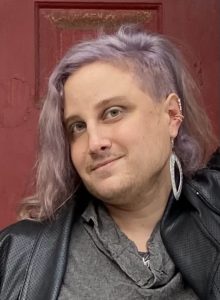

My Authentic Voice: Expanding the Sound Between Man and Woman
By: Z Paige Lerario, MD, NYS CRPA/CPS-p
May 2, 2022
Blog originally posted in:
Neurology Blogs, Voices: Lived Experience
Based on the original research article published in:
The Journal of Speech, Language, and Hearing Research
In collaboration with the team at New York University’s:
Acoustic Phonetics and Perception Lab
Nearly a decade ago, when I started to come out as transgender, I knew I had two major counts against me if my goal was to “pass” as a cisgender woman in society. One was my large skeletal size, and the other was my deep, natural voice. At the time, I was too afraid to irreversibly change my biology with vocal feminization surgery. So, I was excited to find affordable vocal feminization services at NYU’s Speech-Language-Hearing Clinic in 2014.
“We need more nonbinary voices speaking out publicly.”
Words Matter: The words we use to describe gender influence how listeners perceive gender.
Learn more about pronouns and and gender wording issues at:
As a clinical resident in neurology, my paycheck barely covered the rent and utilities of my fourth-floor walkup apartment on the Upper East Side, which had twice more animals living in it than rooms. Health care insurance coverage of medically necessary, transition-related expenses was not a privilege I had at the time. I paid low-fee, out-of-pocket expenses to meet confidentially with students supervised by expert speech pathologists for vocal feminization services. I remember begging them not to tell anyone that I went there, since I worked frequently with speech pathologists in New York City as part of my job as a neurologist. The care and compassion I received in this clinic remains some of the best treatment I have received by any healthcare provider during my transition. They say you “get what you pay for,” but I think health care too often overlooks the healing value of providing an affirming environment to patients from historically oppressed communities.
At the time, I was in intense denial of my transgender identity, and I dared not use the word “transgender” out loud in my sessions. Nevertheless, I was encouraged gently to explore my physical and vocal femininity, and I was thanked for my presence and authenticity. There were support groups with others at similar points in their transitions who were also struggling with their vocal identity. I even wore some makeup and women’s jeans during one of my sessions.
The most intense gender euphoria I experienced during my transition came in a letter from this clinic describing my semester performance achievements. The first sentence described me as a “transgender woman.” I felt these words made my existence real for the first time ever. Although I had never used these words myself, this report from my assigned speech pathologist had provided me with the permission to be myself. Still to this day, I never allowed another person to read this letter. At the time, I was too afraid that if someone invalidated this experience, I wouldn’t have the confidence to come out and transition. Today, I know no one can take my identity away from me, but I keep that letter to myself, proof that I owe no one of my existence.
Another important lesson that I learned at NYU is how disabling and life-limiting a masculine voice can be for some transfeminine speakers. My masculine voice seemingly gives permission to others to question my existence. Male puberty poisoned my larynx, and feminizing hormones could not restructure my misshapen vocal organ. As my body changed with hundreds of thousands of dollars of doctor’s visits, medications, and surgeries, my natural speaking voice remained the same as before my transition, without dedicated intervention. I felt like my voice was no longer mine, and the dissonance between my speech and physical appearance became apparent.
If I chose to use the phone, I either allowed myself to be misgendered and unseen, or I risked outing myself and the resultant discrimination that follows. Therefore, I stopped using the phone whenever I could.
When I publicly spoke or met a new person, I needed to make a quick judgement as to the safety of using my natural voice or manipulating my vocal gender expression to match my physical appearance. This is an exhausting exercise, and I often made mistakes on who was safe to trust when revealing my gender identity. The process of coming out never ends.
I dare not use my natural voice at airport security or in geographic regions that delegitimize the existence of transgender identities. These situations could pose threats to my human rights or physical safety. Although my identity is nonbinary, and therefore “passing” is not a goal of mine, I acknowledge that in many spaces being visibly or audibly gender nonconforming can be dangerous emotionally and physically. I hope safety for the transgender community improves, but on the Transgender Day of Remembrance, we count the number of brutally murdered transgender people.
As a result, my life feels painstakingly performative, and the stigma of transgender identity can be silencing. I frequently code-switch between either speaking in my natural voice and a learned feminine vocal expression, or even between speaking and remaining silent. When my performance fails, I constantly fight to not internalize the stigma of gender nonconformity and the resultant public humiliation, defeat in self-confidence, and societal devaluation which may come with it, especially if I’m having an already bad day.
These concerns were specifically measured by the Steinhardt clinic throughout my gender transition. Two scales were used, the Voice Handicap Index (VHI-10), a scale commonly used to measure impairment for people with voice disorders, and the Trans Woman Voice Questionnaire (TWQV), a scale developed to specifically look at the voice concerns of transfeminine speakers. I scored a 68 on the VHI-10 in June 2020, which ranges from 0-120. Scores over 60 on the VHI-10 indicate severe impairment, as seen with patients with vocal cord paralysis or severe vocal fold scarring.1 My areas of highest disability were noted in the questions: “I find other people don’t understand my voice problem” and “my voice problem upsets me.” Through gender-affirming medical services, including feminizing speech therapy, my scores on the TWVQ, a self-evaluation survey consisting of 23 questions, I found my scores and self-confidence gradually improve by almost 75%.2 For me, such gender-affirming services are lifesaving. They should be considered medically necessary and covered by health care insurance on a national basis.
I do not aim to project my experience onto others: many transgender people are not disabled, by their voices or otherwise. Most transgender people lead functional, inspiring, productive lives doing everything and anything. Many had the confidence to be themselves for decades before me. And every transgender person — past, present, and future — is my role model, as every transition is unique, inspiring, and educational in its own light.
I am privileged to benefit from the system those before me have begun to change, and for so many reasons, still requires much substantial change. We are everywhere and have been everywhere throughout our shared human histories. Now, I hope more of us make the difficult decision to be ourselves visibly and to stop conforming to a gender binary that is holding us back from recognizing the true beauty and diversity of gender and sexuality. We need more nonbinary voices speaking out publicly.
References:
1. Jacobson BH, Johnson A, Grywalski C, Silbergleit A, Jaconsen G, Benninger MS. The Voice Handicap Index (VHI): Development and Validation. American Journal of Speech-Language Pathology 1997;6(3):66-70. https://doi.org/10.1044/1058-0360.0603.66
2. Dacakis G, Davies S, Oates J, Douglas J, Johnston J. Development and preliminary evaluation of the Transsexual Voice Questionnaire for male-to-female transsexuals. J Voice 2013; 27(3):312-320. doi:10.1016/j.jvoice.2012.11.005
